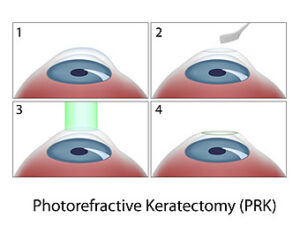Looking for a way to finally say goodbye to glasses and contact lenses? The procedure that may come to mind first is LASIK but it’s not the only option.
LASIK is one of many excellent vision correction procedures available. Undergoing a vision correction procedure can reduce the need for any visual aids like glasses and contacts.
If you aren’t a good LASIK candidate, you may think that your dreams of vision correction aren’t possible, but they are. You may be a better fit for another similar procedure called PRK.
If you’ve never heard of PRK before or are skeptical, it produces almost identical results to LASIK. Keep reading to learn more about PRK and find out why it’s worth considering if you’re not a LASIK candidate!
PRK vs LASIK

It may surprise you to learn that PRK came before LASIK. Although LASIK is very popular, PRK was the first refractive procedure.
Like LASIK, PRK works by correcting refractive errors. These include nearsightedness, farsightedness, and astigmatism.
PRK also uses an excimer laser to permanently reshape the cornea. It is the reshaping of the corneal tissue that corrects refractive errors.
Using the excimer laser, the cornea is gently reshaped to your exact prescription, which fixes how light refracts through the eye. Both LASIK and PRK work in the exact same way, except for one key difference.
The biggest difference between LASIK and PRK is that during PRK, your surgeon will not create a flap in the cornea. A crucial component of LASIK is that it involves creating a small flap in the cornea.
The excimer laser works under the flap to shape the cornea to your prescription. The flap then acts as a natural bandage when replaced on top of the cornea, protecting your eye as it heals.
Thanks to the flap, there’s no need for bandages, stitches, or other adhesives as the eye heals after LASIK. But with PRK, there’s no flap created.
Instead, your surgeon will remove the outer layer of your eye, called the epithelium. After they’ve removed the epithelium, the cornea is directly reshaped on the surface.
What does this difference between the two procedures mean? The biggest difference between LASIK and PRK is that the recovery for PRK is longer. But if you’ve been told that you aren’t a good LASIK candidate, this is an excellent way to achieve almost identical results.
PRK Provides Almost Identical Results to LASIK

To have LASIK, your corneas need to be thick enough to create a flap in the cornea. If your corneas are too thin, creating this flap could become unsafe.
It could also lead to serious visual complications. Most patients that want LASIK have thick enough corneas, but this isn’t the case for everyone.
The only way to know if you have corneas that are the right thickness is to schedule a LASIK consultation. Corneal thickness isn’t something you can determine by looking in a mirror.
Only an eye care professional can tell you if your corneas are thick enough for LASIK. Having a thinner than average cornea isn’t a medical problem, but it does mean you can’t get LASIK.
But if it’s the only thing preventing you from getting LASIK, PRK is the perfect alternative because you don’t need to have a corneal flap created. The results from PRK are just as good as the results from LASIK are.
Over 95% of patients achieve 20/20 vision or better. The recovery period is longer after having PRK, but it’s worth it for excellent vision!
Recovering After PRK

It’s important to note that the recovery after PRK takes longer than LASIK’s recovery. Part of this is due to there not being a corneal flap.
Without a flap, recovering from PRK requires the epithelium layer to regrow. For most patients, this takes about two weeks.
During this process, you’ll need to wear a special contact lens bandage to protect your eye. The initial discomfort associated with recovering from PRK may take longer to dissipate than LASIK’s recovery as well.
Initial recovery from LASIK also takes about two weeks, although the initial discomfort usually only lasts a day or two. Even if your eyes still feel sensitive, you should be able to return to many of your normal activities within a few days of having PRK.
It does take a few months before your eyes have completely healed after PRK. However, it also takes a few months for the corneal flap created during LASIK to heal as well.
You also won’t achieve your best vision until your eyes are fully healed, but that’s the same case with LASIK. You’ll have immediately improved vision and your vision will only continue to improve as you heal.
PRK patients do tend to take longer to achieve their perfect vision than LASIK patients, but the end results are the same.
Experience the Visual Freedom You’ve Always Dreamed Of

PRK can give you the visual freedom that you want, even if you find out you can’t have LASIK. The procedure is painless to undergo and while the recovery process can take a little longer, it’s still very doable.
But visual freedom is worth these minor discomforts. PRK has been around for longer than LASIK and is still performed today. After all, even if you don’t qualify for LASIK, you should still be able to experience life without visual boundaries.
PRK can give you the results you want, regardless of if LASIK is right for you. Like other medical procedures, PRK has only continued to evolve since it was FDA-approved. With almost 40 years of research and clinical studies about it, PRK is a well-understood and effective procedure.
Like LASIK, PRK is permanent. If you get PRK, there’s a good chance that you’ll achieve 20/20 vision or better. Even better? You’ll have decades of beautiful, clear vision to look forward to!
Ready to consider PRK even though you found out LASIK isn’t right for you? Schedule an appointment at Loden Vision Centers in Nashville, TN, now to learn more!
Isn’t it time to see brilliantly without anything holding you back?


